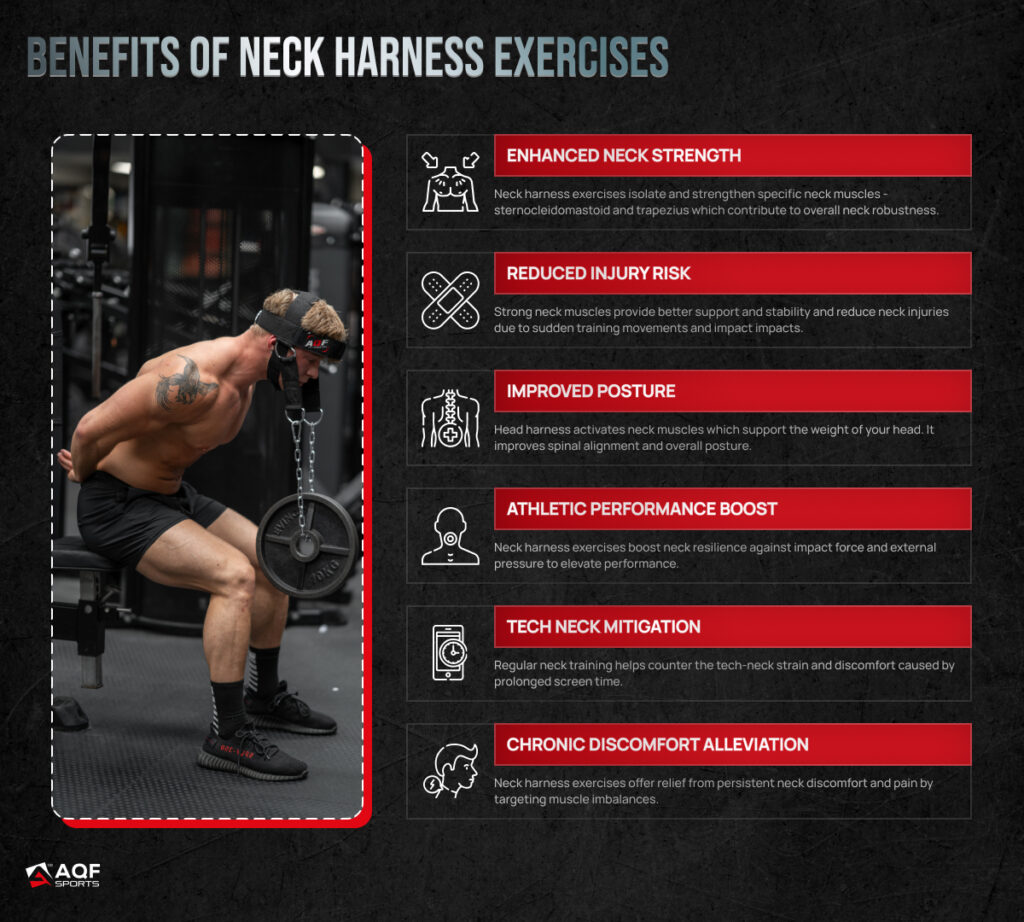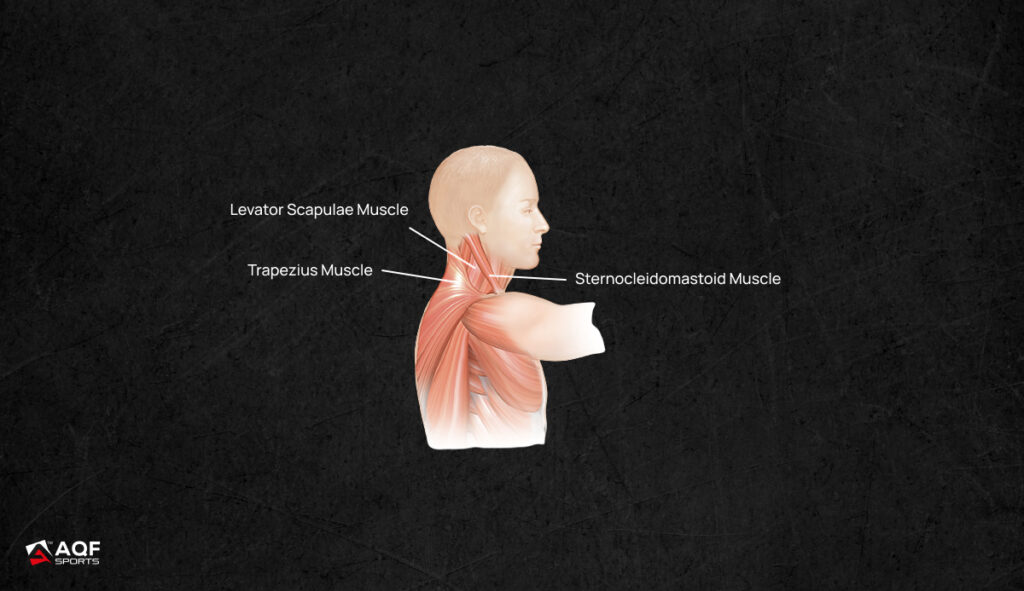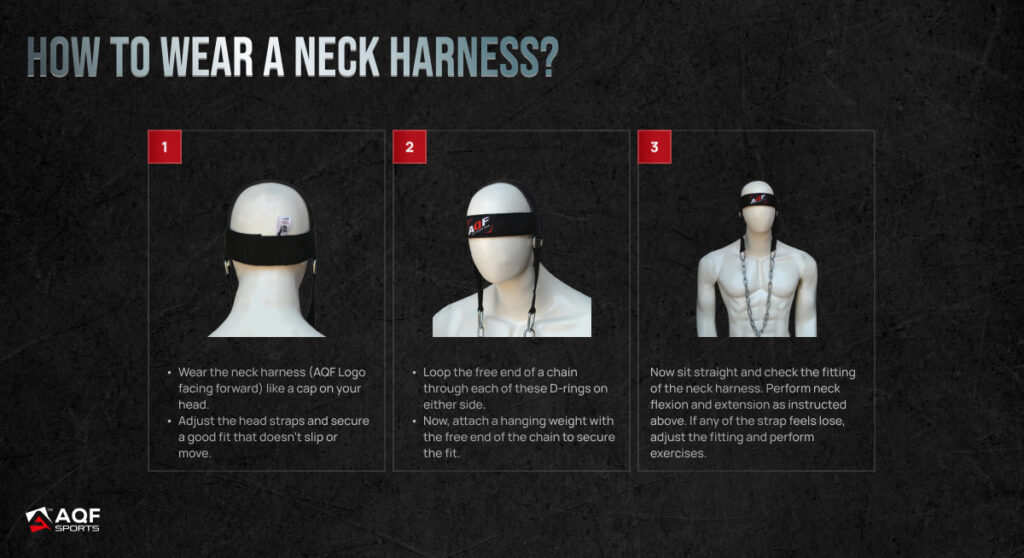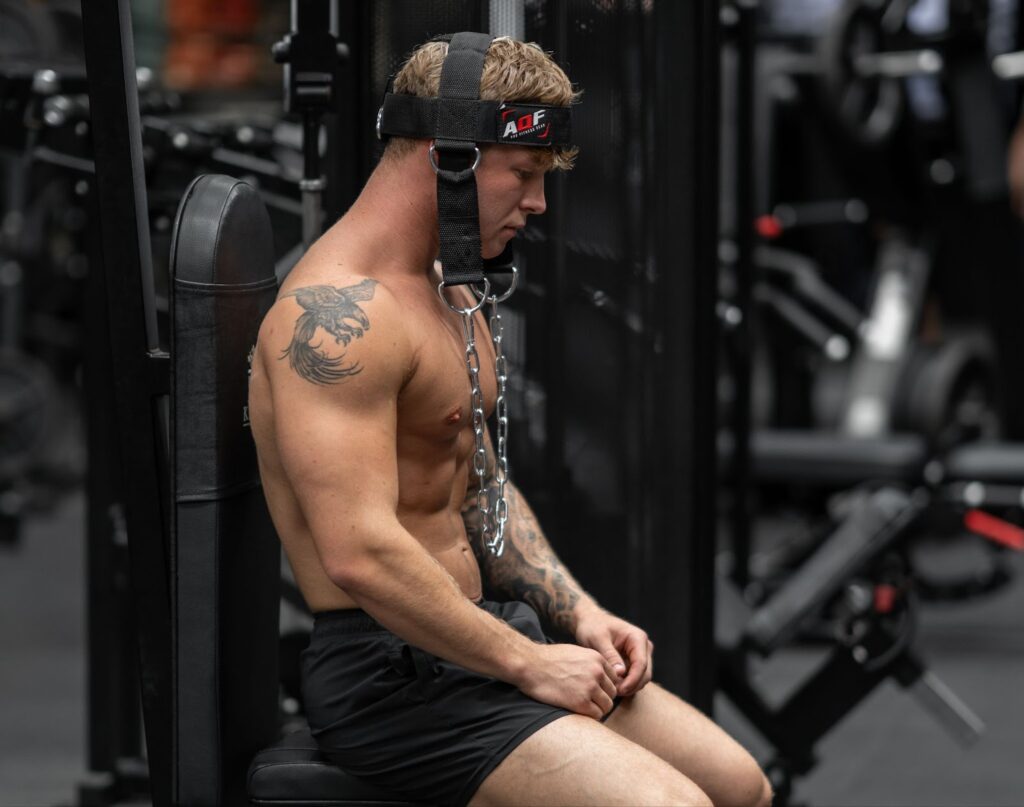Neck Harness Exercises: How to Build Thick Neck Muscles?

Skipping neck day? Huge mistake! Weak neck muscles cause a lot of problems such as cervical pain, poor posture, and susceptibility to neck injuries.
Neck harness exercises are an important aspect of strength training regimen for athletes, MMA fighters and weightlifters. Even if you are a regular gym-goer, neck exercises can help you prevent “tech-neck” which leads to poor posture and pain.
Getting started with head/neck harness exercises is a bit daunting – especially for beginners. Figuring out how to wear the harness and perform exercises appropriately requires some level of adaptation and learning. Don’t worry, we have addressed all your concerns in this blog.
In this blog, we will cover:
- Purpose of a neck harness
- How to wear a neck harness
- Benefits of neck harness exercises
- Best neck harness exercises for stronger neck
- What things to look for when buying a neck harness
What is the Purpose of a Neck Harness?
A neck harness is a specialized fitness tool designed to strengthen the muscles in your neck. It consists of a strap or harness with D-Rings on either side.
You can attach one end of a chain with the D-rings and the free end with hanging weight to perform neck exercises involving controlled neck movements against resistance.
What are the Benefits of Neck Harness Training?

Injury Prevention:
Strengthening the neck muscles can help reduce the risk of neck injuries, particularly in activities where your head might be subjected to sudden jolts or impacts, like contact sports.
Improved Posture:
A strong neck can contribute to better overall posture, as it helps support the weight of your head and maintain proper alignment of the spine.
Neck Stability:
Neck harness exercises can enhance neck stability which is crucial for various daily activities and exercises, such as weightlifting.
Reduce Neck Strain:
If you often experience neck discomfort or strain due to factors like poor posture or prolonged sitting, strengthening the neck muscles can provide relief and support.
Enhance Athletic Performance:
Athletes in sports such as wrestling, football, or martial arts can benefit from neck training, as it can improve their ability to resist forces applied to the head and neck.
Subside “Tech Neck” Pain and Discomfort:
Regular neck harness exercises can counteract the muscular imbalances and strain associated with prolonged screen time, contributing to alleviating the discomfort often referred to as “tech neck”.
Achieve Thicker Neck Muscles with Neck Harness Exercises
Neck Harness training focuses on key neck muscles— the sternocleidomastoid and trapezius. Gradually ramping up resistance in your neck harness training improves strength and stamina.
Neck training activates neck muscle fibers and improves the neuromuscular adaptation to heighten neck muscle bulking, endurance and recovery and bulking.

During neck flexion, your sternocleidomastoid contracts and creates tension exerting tension in your neck while you tilt your head forward against the resistance.
During neck extension, the trapezius muscles activate to counter the resistance and control the backward head movement.
How to Do Neck Flexion:
- Put on the neck harness snugly around your head.
- Stand or sit up straight with your feet shoulder-width apart.
- Slowly lower your chin towards your chest, keeping your neck and back in line.
- Gently lift your head back up to the starting position.
- Repeat this movement as many times as you’d like.
Muscles Activated: Sternocleidomastoid
How to do Neck Extension:
- Attach the neck harness securely around your head.
- Stand or sit straight, with your feet shoulder-width apart.
- Slowly tilt your head backward, away from the resistance.
- Bring your head back to an upright position while resisting the pull.
- Repeat this motion for the number of reps you’re comfortable with.
Muscles Activated: Trapezius
How to Wear a Neck Harness?
A head/neck harness has velcro straps that wrap around the circumference of your head,
Here is how to wear a neck harness:
- Wear the neck harness (AQF Logo facing forward) like a cap on your head
Adjust the head straps and secure a good fit that doesn’t slip or move
- Head/neck harness has 2 D-Rings attached on either side of the head strap.
Loop the free end of a chain through each of these D-rings on either side
Now, attach a hanging weight with the free end of the chain to secure the fit
- Make sure that the weigh is on the floor or in your lap while you are securing the chain attachment to avoid any injuries and discomfort.
Now sit straight and check the fitting of the neck harness. Perform neck flexion and extension as instructed above. If any of the strap feels lose, adjust the fitting and perform exercises.

How much weight should you put on the neck harness?
It depends on your fitness level, experience, and comfort. It’s important to start with a light weight that allows you to maintain proper form and complete your exercises comfortably.
As a general guideline:
Beginners:
If you’re new to neck harness exercises, start with a very light weight, such as 2.5 to 5 pounds. Focus on getting accustomed to the movement and technique before gradually increasing the weight.
Intermediate:
Once you’re comfortable with the exercises and your neck muscles have adapted, you can gradually increase the weight. Aim for weights ranging from 5 to 10 pounds.
Advanced:
For those with significant experience and strength, you can consider using weights ranging from 10 to 20 pounds or more under proper form and control.
Take a Closer Look: How To Lift Heavier Weights: Mistakes To Avoid & Tips To Follow
Are neck weight harnesses safe?
Yes, neck weight harnesses are safe when used correctly and with proper guidance. These harnesses are designed to provide controlled resistance for targeted neck training.
To ensure safety:
- Start Light: Begin with lighter weights to avoid strain or discomfort, gradually increasing resistance as your muscles adapt.
- Proper Technique: Focus on maintaining proper form during exercises to minimize the risk of injury.
- Professional Guidance: Seek advice from fitness experts or healthcare professionals before starting neck harness exercises.
- Comfort: Ensure the harness fits comfortably and doesn’t cause any discomfort or pinching.

Is a neck leash or harness better?
Neck Leash:
Pros:
Real-time Adjustments: Allows for instant and personalized resistance adjustments during training, providing dynamic challenges as your partner applies varying levels of resistance.
Specific Movements: Your training partner can target precise movements and angles, customising the resistance to your needs.
Dynamic Training Scenarios: Suitable for sports-specific training that requires real-time resistance adjustments to mimic game situations.
Cons:
Dependent on Partner: Requires a reliable and knowledgeable training partner to provide consistent and safe resistance.
Safety Concerns: Inappropriate or sudden resistance changes can lead to injury, emphasizing the importance of communication and trust between partners.
Limited Solo Use: Not practical for solo training sessions where a partner is unavailable.
Neck Harness:
Pros:
Solo Training: Enables solo training without the need for a partner, providing independence and flexibility in your workout routine.
Controlled Resistance: Allows for controlled and consistent resistance using added weights, making it suitable for progressive overload and individualized training.
Targeted Strengthening: Designed for focused and isolated neck muscle strengthening, contributing to muscle development and overall neck health.
Cons:
Limited Dynamic Adjustments: Unlike a neck leash, resistance adjustments are not as dynamic during the exercise, requiring you to pre-set the weight.
Proper Technique Crucial: Requires proper technique and adjustment to ensure comfort and safety, particularly when adding weights.
Initial Investment: You’ll need access to a neck harness and weights, which may require an initial financial investment.
How long should you do neck bridges?
The duration of neck bridges using a neck harness depends on your fitness level and comfort. Generally, it’s advisable to start with shorter durations and gradually increase as your neck muscles become accustomed to the exercise.
Begin with 1-2 sets of 8-10 repetitions and then progress over time. Pay attention to how your neck feels during and after the exercise and adjust the duration accordingly.
Technique:
Here’s a step-by-step guide on how to perform neck bridges using a neck harness:
Prepare the Harness:
Adjust the neck harness for a snug but comfortable fit. Attach any necessary weights to the harness, ensuring they hang evenly in front of you.
Get in Position:
Sit on a bench or chair with your back straight and feet flat on the floor. Your head should be free to move.
Start Slow:
Hold onto the bench or chair with your hands for support. Slowly tilt your head backward, allowing the harness to create resistance.
Perform the Bridge:
Lower your head backward in a controlled manner, feeling the resistance from the harness. Keep your neck and back aligned as you do this movement.
Return to Starting Position:
Gently lift your head back up to the starting position, again maintaining control and alignment.
Breathe:
Remember to breathe evenly throughout the exercise.
Reps and Sets:
Complete the desired number of repetitions (start with 8-10) for one set. Rest for a minute and then perform another set if you’re comfortable.
Extend Your Knowledge: Rest Pause Sets Training: Benefits, Variations and Techniques
Progress Gradually:
As your neck strength improves, you can gradually increase the repetitions and sets.
Important Note:
Neck bridges can be challenging, and it’s crucial to prioritize safety. If you’re new to neck training or have any concerns, it’s wise to consult a fitness professional or healthcare provider before attempting neck bridges or any other neck exercises.
How did Mike Tyson train his neck?
Check out this incredible video showing how Mike Tyson trained his neck:
What things to Look for When Buying a Neck Harness?
A neck harness is a vital tool for targeted muscle strengthening and conditioning. To ensure you make an informed purchase, we’ve assembled a detailed buying guide tailored to your needs:

Adjustability for All Fitness Levels:
Buy an adjustable harness as it is more suitable for accommodating beginners to advanced athletes. Customization ensures optimal comfort and effectiveness in every workout.
Comfortable and Sturdy Material:
Get harnesses with a soft neoprene lining for enhanced comfort. A design that prevents abrasions and distractions enables an immersive and enjoyable training experience.
Heavy-Duty Steel Chain:
Opt for a harness featuring a sturdy 30-inch steel chain, equipped with robust D-ring connectors and a reliable clip closure.
Verify its weight-bearing capacity, ensuring it can handle your most intense training sessions.
Velcro Closure System:
Look for a harness designed with an easy-to-use Velcro closure system. Swiftly don, adjust, and secure the harness, saving you precious workout time.
Universal Fit:
Choose a one-size-fits-all design. Harnesses with adjustable straps allow you to achieve your preferred tightness, irrespective of your size.
The Bottomline
Neck harness exercises are an effective way to build thick neck. These workouts specifically target and strengthen key neck muscles, such as the sternocleidomastoid and trapezius to improve neck muscle strength and endurance. Moreover, neck harness exercises reduce injury risks, support posture, and improve athletic performance.
Neck Harness Exercises – Frequently Asked Questions
How long does it take to build neck muscles?
Initial Progress (4-8 weeks): In the first month or two of regular training, you might notice small improvements in muscle tone and strength due to your nervous system adapting.
Visible Changes (2-6 months): With consistent training, you’ll likely see more noticeable muscle size and definition. Eating well and getting enough protein helps.
Significant Growth (6 months – 1 year or more): Building noticeable muscle mass takes time. Several months to a year or more of dedicated training, plus proper recovery, is needed.
Tips:
- Genetics Play a Role: Everyone’s different, so results vary.
- Train Regularly: Aim for 2-3 neck workouts per week.
- Eat Right and Rest: Good nutrition and sleep help muscles grow and recover.
- Challenge Yourself Gradually: Increase resistance over time.
- Be Patient and Safe: Building muscles takes time, so avoid rushing and overtraining.
Can weak neck muscles be strengthened?
Absolutely, weak neck muscles can be strengthened through targeted exercises and consistent training. Just like other muscles in your body, neck muscles respond to progressive overload, where you gradually increase resistance and intensity over time. Here’s how:
Isometric Exercises: Isometric exercises involve contracting your muscles without movement. For the neck, gently press your hand against your forehead, sides, or back of your head and hold for a few seconds. This helps activate and strengthen different neck muscles.
Neck Harness Training: Using a neck harness and adding weights gradually can effectively build neck strength. Start with lighter weights and progress as your muscles adapt.
Neck Flexion and Extension: Slowly nodding your head forward (flexion) and backward (extension) against resistance helps target various neck muscles.
Resistance Bands: Attach a resistance band to a stable surface and gently perform neck movements against the resistance.
Neck Bridges: Lie on your back with your head off the edge of a bed and gently lift your head, strengthening your neck muscles against gravity.
Consult a Professional: If you’re new to neck training or have concerns, seek guidance from a fitness professional or healthcare provider to ensure safe and effective exercises.
How can I build my neck muscles fast?
Progressive Resistance: Start with a comfortable weight for exercises like neck flexion, extension, and lateral movements. Gradually increase the weight by small increments (e.g., 2-5 pounds) as you become more comfortable and confident.
Focused Frequency: Train your neck muscles 2-3 times per week. For each session, perform 3-4 sets of 8-12 repetitions for each exercise.
Diverse Exercises: Include a variety of exercises in your routine, such as neck harness flexion and extension, resistance band movements, and isometric holds against your hand’s resistance.
Optimal Technique: Maintain proper form throughout exercises. Focus on controlled, deliberate movements to maximize muscle engagement and minimize risk.
Nutritional Support: Consume sufficient protein to aid muscle repair and growth. Aim for about 1.2 to 1.6 grams of protein per kilogram of body weight per day.
Rest and Recovery: Allow at least 48 hours between neck workouts for muscle recovery. Adequate sleep and hydration also play a role in optimal recovery.
Explore Related Topics:






